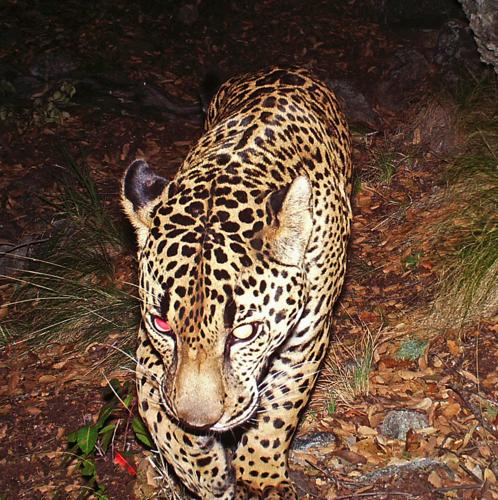A judge has clarified that only the 50,000 acres containing the proposed Rosemont and Copper World mine sites will be removed from a key area of federally protected jaguar habitat south of Tucson due to a recent Appeals Court ruling.
U.S. District Judge James Soto’s ruling last week leaves another 301,000 acres of protected jaguar habitat intact on land lying south of the prospective mine sites. A May ruling from the federal 9th Circuit Court of Appeals had raised the possibility that those lands could also be pulled out of critical habitat but Soto’s ruling didn’t even mention them.
Hudbay Minerals Inc. has proposed building first the Rosemont Mine on land on the Santa Ritas’ east slope and now proposes the much larger Copper World Mine project on the range’s east and west slopes. The west slope is entirely private land, while the east slope contains a mix of federal and private land.
The 9th Circuit ruling had faulted the reasoning the U.S. Fish and Wildlife Service used in designating the entire 351,000 acres of what’s called Unit 3 of jaguar critical habitat, but the ruling created uncertainty, even among some of the parties to the lawsuit, as to what land would stay in and what would come out of critical habitat.
This week, Hudbay officials and officials of the Tucson-based Center for Biological Diversity said they had agreed on removing the 50,000 acres and not the 351,000 acres. The center had fought and lost in court to try to keep all the 351,000 acres inside critical habitat.
The third party involved in the lawsuit, the Fish and Wildlife Service, declined to comment on Soto’s ruling, spokeswoman Jessica Zehr told the Star Tuesday. The wildlife service had also declined to comment on the original 9th Circuit ruling in May.

The Santa Rita Mountains southeast of Tucson.
The ruling concludes Hudbay’s appeal of an earlier decision by Soto, who in February 2020 upheld Fish and Wildlife Service’s designation of the northern Santa Rita Mountains as critical habitat for jaguars.
The final order, issued on Aug. 11, doesn’t affect the permitting for Copper World’s first phase, which covers exclusively private land, Hudbay said. Typically, critical habitat designations are brought to bear on proposed projects only if they need some kind of federal permit, which Hudbay says it won’t need for that first phase.
But the ruling “should simplify the federal permitting process for Phase II of the project,” which includes federal land, the company said. If the federal land isn’t in critical habitat, fewer restrictions will exist on mining there. Federal law prohibits destruction or “adverse modification” of critical habitat for an endangered or threatened species.
Under the U.S. Endangered Species Act, federal officials are legally required to designate critical habitat if they can show such land is “essential” for conservation and recovery of an imperiled species such as the jaguar. The 9th Circuit’s May ruling said Fish and Wildlife had failed to prove that the 351,000 acres in question were essential for the jaguar.
The Center for Biological Diversity is unhappy about the loss of critical habitat from the Rosemont site due to the 9th Circuit ruling, said Michael Robinson, a conservation advocate for the center.
But because “we lost that court ruling, it now comes down to how it will be interpreted,” Robinson said, and the center has signed off on the plan approved by Soto’s ruling.
The center still has pending before the wildlife service a much more ambitious proposal to designate more than 14.6 million acres in Southern Arizona and New Mexico as critical habitat.
“Jaguars have roamed the Santa Rita Mountains since time immemorial and they need this Sky Island mountain range for their recovery,” Robinson said. “We’re extremely disappointed with this ruling, but we’ll keep fighting to protect the Santa Ritas for jaguars and other imperiled species who need this wild habitat to survive and thrive.”
Soto’s new ruling also withdrew from federal protection another 12,710 acres of land from a separate unit of critical habitat. That area had been clearly designated for removal by the 9th Circuit ruling.
A male jaguar not previously detected by researchers was videotaped just three miles south of the recently constructed border wall between Mexico and the United States.
The jaguar appeared for the first time on camera traps along the riparian corridor of Cajon Bonito in Sonora, Mexico. The lands where the jaguar was recorded have been managed by the Cuenca Los Ojos foundation to preserve and restore biodiversity during the last three decades. Researchers have dubbed the jaguar El Bonito.
Credit: Ganesh Marin, the project leader, is a Ph.D. student in the School of Natural Resources and the Environment at the University of Arizona and a National Geographic Early Career Explorer. The research project is a joint effort of the University of Arizona and the University of Wyoming in collaboration with the Cuenca Los Ojos Foundation and members from Santa Lucia Conservancy, National Autonomous University of Mexico (UNAM), Phoenix Zoo and Arizona State University.






